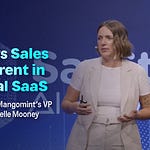Rob Giglio, Canva's Chief Customer Officer, shares the playbook for scaling from 170M to 230M monthly active users while building enterprise sales without compromising company culture.
Top 5 Takeaways
1. PLG-to-SLG is Far Easier Than SLG-to-PLG Going from product-led growth to sales-led growth is significantly easier than the reverse. Companies with strong PLG foundations have rich product usage data and customer engagement signals that can be leveraged for enterprise sales. The data infrastructure is already there—it just needs to be redirected toward sales motions.
2. Don't Build Two Cultures—Extend One Canva deliberately avoided creating a separate "enterprise culture" with traditional deal-making behaviors. Instead, they extended their existing customer-first culture into enterprise sales, maintaining their philosophy of "give value first, get value second" even in complex B2B transactions.
3. Treat All Customers Like Gold, Regardless of Revenue Don't segment customer success based on how much customers pay. A free user helping their kid with homework might be the CCO of a Fortune 500 company. Canva focuses on helping customers solve problems and move through their journey, knowing that value creation leads to revenue growth.
4. Post-Sale Orchestration Should Match Pre-Sale Excellence SaaS companies excel at customer acquisition funnels but often neglect post-sale orchestration. Since most SaaS businesses have larger install bases than new customer acquisition, the real value lies in orchestrating exceptional post-sale experiences with the same rigor applied to marketing funnels.
5. Data → Signals → Actions Framework Effective enterprise sales in a PLG environment requires a systematic approach: collect product usage data, transform it into actionable signals, and create specific actions for sales teams. This isn't cold outbound—it's warm outreach to companies already using your product.
AI at Canva: 16 Billion Interactions and Counting
Before diving into enterprise strategy, it's worth understanding the scale of AI adoption at Canva. The company has generated 16 billion instances of AI usage, ranking among the top AI use cases globally alongside industry leaders.
Canva approaches AI through two distinct lenses:
Customer-Facing AI: Making Design Accessible
The majority of Canva's AI focus goes toward customer-facing features that help users scale imagery, ads, and content creation. This isn't about flashy AI demonstrations—it's about solving real design problems for millions of users who lack professional design skills.
The philosophy mirrors Canva's original mission: take complex things (professional design) and make them simple (accessible to everyone). AI becomes another tool in this democratization effort.
Internal AI: Augmenting Rep Performance
For internal operations, Canva focuses on identifying complex workflows and experiences for sales and customer success reps, then "stitching AI next to those to make them easier."
The Framework: Data → Signals → Actions
Data: Rich product usage information from PLG motion
Signals: AI-powered insights about customer behavior and needs
Actions: Specific next steps for reps based on AI analysis
Build vs. Buy Strategy: Rather than building custom AI tools, Canva starts with existing market solutions and implements them into workflows. They're "willing to try almost anything if it's a reasonable investment."
Scaling Philosophy: The same customer-first approach that built their PLG motion now guides AI implementation. Get it right for customers first, then optimize for internal teams.
This AI foundation becomes crucial for the enterprise motion, where the ability to process signals from hundreds of thousands of users and turn them into actionable sales intelligence makes warm outbound possible at scale.
The Journey from 170M to 230M Monthly Active Users
When Rob Giglio joined Canva as Chief Customer Officer, the company had already built one of the most successful PLG motions in SaaS history. But to fulfill their mission of "empowering the world to design," they needed to reach users inside enterprises—environments where IT administrators control software access.
The challenge wasn't just building enterprise sales; it was doing so without compromising the culture that made Canva special.
Green Flags: The PLG Advantage
Canva entered enterprise sales with several advantages that pure-play enterprise companies lack:
Rich Product Usage Data: Years of PLG operation had generated massive amounts of user behavior data. While this data wasn't initially configured for sales use, the foundation was solid.
Enterprise Product Intent: Rather than trying to force-fit a consumer product into enterprise environments, Canva was intentionally building enterprise-specific features and capabilities.
Proven Product-Market Fit: With 170M monthly active users (now 230M) completing designs—not just opening the app—Canva had demonstrated real value creation at scale.
Red Flags: The Cultural Challenge
The transition wasn't without risks:
No Enterprise Sales Experience: The team had never built a sales-led motion before.
Touchless Culture: The company culture was built around organic, network-driven adoption without human intervention.
Redefining Network Effects: They needed to understand what "organic network-led adoption" looks like inside an enterprise environment.
The Solution: Customer-Centric Organization Design
Rather than traditional sales titles, Canva adopted the "Chief Customer Officer" structure—organizing all customer-facing teams (sales, success, operations) under one leader focused on the customer. This approach:
Forces organizational focus back to the customer
Breaks down silos between pre-sale and post-sale teams
Eliminates the artificial separation between PLG and enterprise customers
The Enterprise Sales Playbook
1. Unified Customer Population
Canva rejected the traditional model of separate teams for PLG users versus enterprise customers. Instead, they view all users as part of one population with different needs and engagement preferences.
The Philosophy: Whether someone pays $0, $100, or $100,000, they're solving design problems. The support model should scale based on complexity and volume, not arbitrary revenue thresholds.
2. Signal-Based Sales Development
The enterprise motion leverages PLG data through a structured framework:
Network Effects Within Organizations: Track multi-user adoption and collaboration patterns within company domains
Digital Touchpoints First: Send automated signals through email, in-product notifications, and retargeting before human outreach
Warm Outbound: Sales development focuses on companies already using Canva, not cold prospects
3. Process and Skill Integration
Canva implemented Winning by Design's SPICED methodology with their own cultural adaptations. But process alone isn't enough—the underlying skills matter more:
Clear Problem Definition: Daily focus on the specific problems being solved for customers
Genuine Conversations: Emphasis on empathetic, authentic customer interactions over scripted pitches
Cross-Team Collaboration: Customer Success, AEs, and BDRs work together rather than in separate silos
AI and Scaling Philosophy
Canva approaches AI implementation with the same customer-first philosophy:
Customer-Facing AI: 16 billion instances of AI usage for design creation, ranking among top AI use cases globally.
Internal AI: Focus on making complex workflows easier for sales and success teams, using existing tools rather than building custom solutions.
Data-Driven Framework: The same "Data → Signals → Actions" framework guides AI implementation, ensuring AI serves the customer journey rather than replacing human judgment.
The Economics of Customer Success
One of Rob's most compelling arguments centers on the economics of customer support. Most SaaS companies excel at customer acquisition orchestration but underinvest in post-sale experiences.
The Math: In most SaaS businesses, the install base significantly exceeds new customer acquisition in any given quarter. Yet companies often spend 80% of their orchestration effort on acquisition and 20% on retention and expansion.
The Opportunity: Flipping this ratio—or at least achieving parity—can dramatically improve unit economics and reduce churn while increasing expansion revenue.









